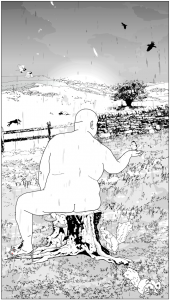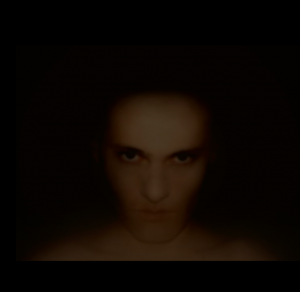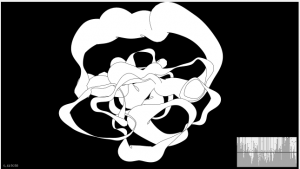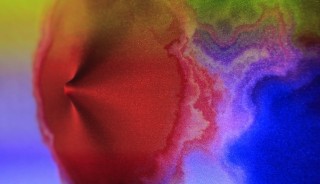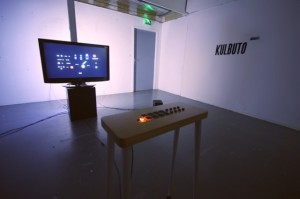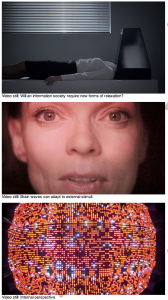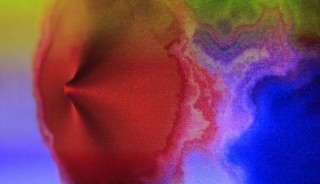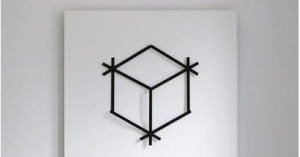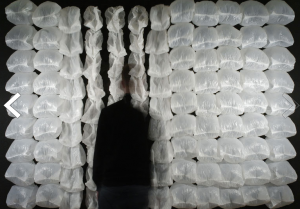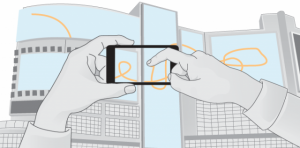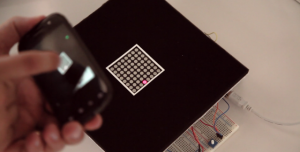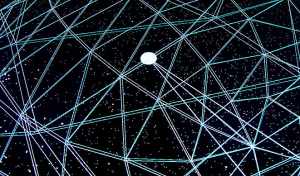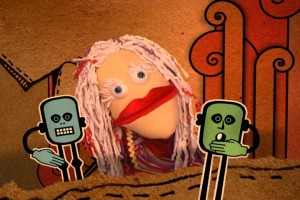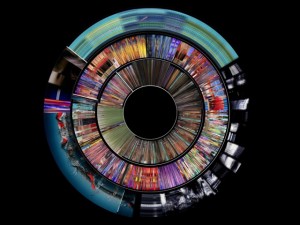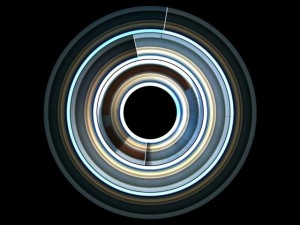Outwards III
Mesocosm (Northumberland UK) by Veronique Brossier, Xue Hou, Andrea Lira, Laewook Kang
http://www.o-matic.com/play/friend/mesocosm/index.html
Mesocosm is a massive project, it is a 146 hour, real time cycle of life on the Northumberland moors. The user can choose to begin the cycle in the winter or in summer, and as it starts, the contour of a figure based on Leigh Bowery sits atop a tree stump. He makes these minute, subtle movements and after awhile, the whole scene comes alive in the most mesmerizing and captivating way. Woodland creatures appear, birds, squirrels, countless animals. The weather changes, the sky moves, the sun sets and rises. Sometimes refugees and travelers appear on the hill beyond the fences and sometimes, the animals eat Leigh Bowery’s flesh (the red of his skin is the only color in the entire animation), and he frequently up and dances. There are countless events that occur, and a probability equation codes the animation to ensure it is never the same. I absolutely love this animation, I find it just breath taking in the complexity it generates from such simple imagery. Watching the events of the animation takes patiences, but all of the delightful treasures that appear on the screen truly make it well worth the wait. I suggest just leaving it open in your browser and checking up on the moors every so often.
Adam001 created by Yuli Ziv 2001
http://www.yuliziv.com/adam001.html
Adam is a virtual entity that encompasses all of the “fragments of human energy scattered around the virtual world” in one “being”. It is an interactive web program that takes you on a bizarre, eerie and surreal journey through the internet by clicking on various part’s of Adam’s body (his forehead, collarbone, brain, penis etc). I just realized that the program’s name is a biblical illusion, as Adam was the first man and Adam001 is the first It seems like the program draws constantly on internet happenings and re-calibrates to reflect them. Its a comparatively a rather old program (which is apparent graphically) and a bit theatrical but I quite enjoy messing around in it. I think it’s a fascinating concept, the idea of trying to amalgamate every persona and character we create on the web and watch it become this dark, brooding thing that sees and knows everything.
Entrails (openFrameWorks) by Lukasz Karluk
<iframe src=”http://player.vimeo.com/video/26801065?title=0&byline=0&portrait=0″ width=”400″ height=”225″ frameborder=”0″ webkitAllowFullScreen allowFullScreen></iframe><p><a href=”http://vimeo.com/26801065″>entrails</a> from <a href=”http://vimeo.com/julapy”>lukasz</a> on <a href=”http://vimeo.com”>Vimeo</a>.</p>
This video is the a preview of a project in progress by Lukasz Karluk. The final product will be a program that makes contours and polylines reactive to audio stimuli. Right now the program animates in black and white, which is something I personally hope they keep as the minimal aesthetic of the white contours against the stark black background really appeals to me. I like the energy of the lines and how expressive and active they are even in their unfinished state. The flashes of the purple blueprint code lines (I’m not entirely sure what they actually are) gives the animating great perspective, and I just always really like to see unfinished works and creative processes. Watching this would be so entertaining at a party.

